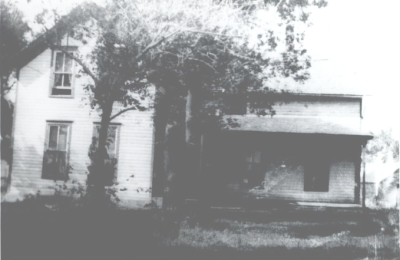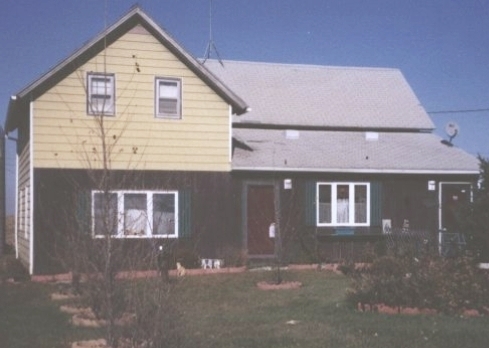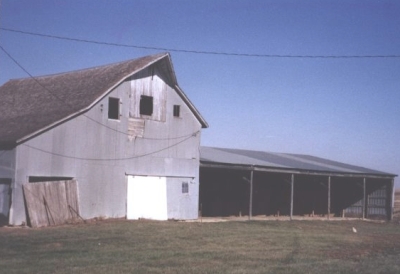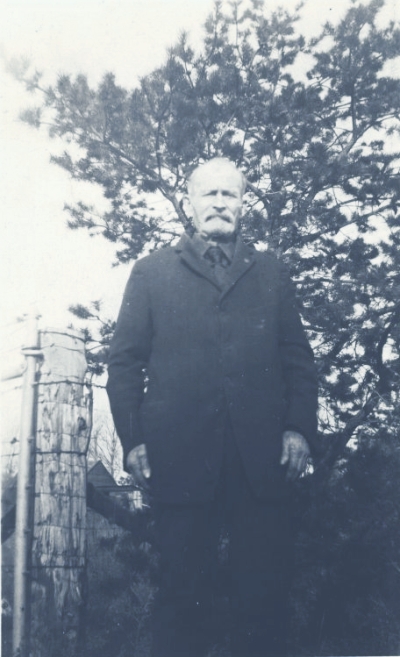The David Whitney Story
Part III – Chapter 2
A Pioneer Farmer with Family
Breaking Sod, Starting a Family, and Building a House
When David arrived in July 1872 at the site west of Sibley where he settled with his bride of nine months, Mary Jane was already six months pregnant with their first child. Since they were intending to make their home on this spot of the high plains where prairie grass dominated the landscape with no native trees in sight, David provided the first shelter for his soon-to-be young family of three by carving a dugout sodhouse from the rich black loam of Northwest Iowa just a few miles below the border with Minnesota.
On September 12, 1872, Mary Jane delivered a son, who they named Walter Eugene Whitney after David's youngest brother born exactly 16 years earlier, on September 12, 1856. With the first signs of winter weather due to approach this portion of Northwest Iowa not too long after his son's birth, David bought some lumber in LeMars and built on his farmstead a frame house with some common rough boards and tarpaper for siding, completing it on November 10, 1872. Although it was a one-story house, it did have a loft in which they could sleep above the cold ground-floor
Surviving NW Iowa Winters
Northwest Iowa in 1872 was not the most comfortable place in the winter, especially for people with meager resources. The flat plains with no trees for protection allowed winter winds to drive fine snow fiercely across open fields in such a way that has come to be known as a 'blizzard'. This term is reputed to have first been printed in the early 1870's in a newspaper in Estherville, a Northwest Iowa town about 50 miles east of Sibley. It appeared in an article reporting a description of the winter storm, perhaps incorporating a word from German spoken by someone from the town of Marshall in neighboring Southwest Minnesota. Whatever its true origin—and etymology is more of an art than a science—the term is used with first-hand knowledge by natives of Northwest Iowa.
The winter before David and Mary Jane arrived in Osceola County had been a harsh one. Railroad construction, important for new settlements, had to be delayed until spring. One man froze to death in January when he was caught out in a blizzard east of Sibley while cutting firewood from willow trees along the Ocheyedan River. In February, another man died while on his way home bringing provisions he had bought in a store in town.
But the Whitney family's first winter was even harsher. A three-day storm that struck in early January 1873 kept Mary Jane and her infant son covered up in bed for the duration. The tarpapered wood walls were not as sheltering from the cold wind as were the thicker walls of the sod dugout, but David did manage to provide some firewood to burn during the storm He had returned home just before the blizzard got heavy with a wagonload of firewood he had cut at the Rock River in Lyon County, west of their farm. He parked the wagon next to the house with handy access for the constant stoking of the fire necessary during the three days of the storm.
At various times that winter, more storms piled layer upon layer of snow on top of each other—as it does in that part of Iowa where there is usually no thawing until spring—so much so that by March the railroad line through Sibley was blocked. As a result, fuel was in short supply, and many people burned hay and marsh grass to keep themselves and their livestock warm.
Spring was late that year and fields were plowed and crops planted behind schedule. Then a drought followed from the beginning of May until the middle of June. Even so, the crops, though their growth retarded, were making progress towards a possibly fair harvest. But in June something came from the sky that changed the farmers' prospects in the fields.
A Grasshopper Assault in the Summer
One Sunday morning in June 1873, people in and around Sibley were astonished by the appearance of a dark cloud in the west approaching swiftly as if driven by the wind. Along with the cloud came a terrible, buzzing roar, making some people think it was a tornado, a hazard well-known to many residents of the plains. Instead of sucking up things from the ground, however, this cloud started falling apart with tiny specks swooping earthward. It was the prairie scourge, grasshoppers, vast multitudes of them!
The bright green stalks of the grain planted for crops turned dark as the swarms landed on them, and the roar of grasshopper wings changed to the munching of all vegetation in sight. Attempts to save the crops went for naught as these long-time insect denizens of the prairie made short shrift of whatever the new prairie residents had planted and of many other things in addition. It was reported that the grasshoppers ate willow leaves as well as boots and overcoats that had been left outside and even gnawed on the wooden handles of farm implements. Some farmers claimed to have seen grashoppers eating the wool on the backs of their sheep.
After destroying the planted crops, the grasshoppers moved on to open prairie-grass fields. Within ten days the insects were gone, but the devastation they caused was felt by everybody in the area. With that year's source of income destroyed, and despite that fact that they were expecting their second child in January, David and Mary Jane left their farm for four months and worked in Cherokee, about 50 miles southeast of Sibley.
A Family Farm Tragedy
Following their first, fierce winter on their prairie homestead and the grasshopper invasion that ruined their first crops that summer, David and Mary Jane returned to the land they had claimed west of Sibley where they, unlike many neighbors, intended to remain despite the hazards of nature peculiar to the area. In fact, they soon increased the size of their landholding, as David claimed the quarter section of land just on the west edge of his original quarter section. Its owner had left in despair of the harsh winter and grasshopper attack, and David, under provisions of the Homestead Act, planted trees on that land to support his claim. David also probably enjoyed anticipating having something on his farm that would remind him of the green, forested hills and mountains of his boyhood home in Vermont, even if he couldn't conjure up the hills and mountains on the endlessly flat prairie.
David and Mary Jane also soon increased the size of their prairie family, with two more sons born in 1874 and 1875, one daughter in 1879 and another soon therafter. By 1884, their oldest, Walter Eugene, was a 12-year-old farmboy who, with several younger brothers and sisters for his parents to feed, had man-like duties to perform, a common experience, especially for the first-born of farm families. However, this farmboy and his family suffered another farm experience, which, though not common directly in most such families, is also not rare: a farm accident.
On September 22, 1884, just ten days after his twelfth birthday, Walter Eugene was out in one of the fields with a team of his father's horses turning the soil with a plow. The horses bolted and Walter was thrown under the plow and cut by its sharp blade. When they found their injured son, David got on a horse and raced to town to fetch the doctor to try to help his son while Mary Jane stayed in the field, cradling her bleeding first-born in her arms. However, Walter died, probably very soon, as a femoral artery—the major circulatory link through the thigh down the leg—had been severed. Such injuries bleed profusely and are hard to stanch.
Their son's tragic death must have been extremely difficult for David and Mary Jane. For a first child—with whom a mother often has special attachment—to die so violently and in his mother's arms must have given Mary Jane sad memories for years to come. And his son's death couldn't have kept from stirring up vivid memories of the death and dismemberment of fallen comrades from David's time in Virginia, Maryland, and Pennsylvania.
But David and Mary Jane still had two growing sons, aged nine and ten at the time. By ten years later they had added one more daughter and five more sons, giving them a total of ten survivng children after nearly 22 years on the prairie, with their last one being born in January of 1894.
A Substantial Farm Despite Another Prairie Hazard
The Whitneys had started with a little house on the prairie that David had built their first year in Northwest Iowa in 1872, but before long they were adding other buildings, including a more substantial house for their expanding family in 1889.
David and Mary Jane Whitney's Expanded House (ca. 1933)

Photo from private collection offamily of Charles W. Whitney, Sr.David's son
David also had a stable, wells with pumps, and what he called his 'forest', the trees and some shrubbery he had planted.In 1884 David built his first barn but experienced another hazard of the prairie with that basic farm building. In 1894 a tornado, this time the genuine kind with monstrously roaring winds—not the roaring wings of miniature monsters—destroyed his first barn. But before long he built a new one to go along with a granary and other small farm buildings.
For his tree claim David had planted maple, cottonwood, boxelder, ash, and catalpa trees and later added fruit trees and shade trees closer to the house. He also had a love for horses and raised many of them, and he also raised and marketed many cattle and sheep. At various times he had planted wheat, oats, barley, flax, and corn as crops in the virgin, rich black soil of Northwest Iowa.
Achieving Standing in the Community
From their lonely beginning in 1872 as young, Osceola County pioneers living on open, treeless prairie in a sod dugout with their first child on the way and facing the fierceness of NW Iowa winters, David and Mary Jane had, by the turn of the century, become prosperous members of their local community with an elegant looking farm.
The Whitney House Today

Photo by Verna SalzmanCourtesy of Duane WhitneyDavid's grandson
The Whitney Barn Today

Photo by Verna SalzmanCourtesy of Duane WhitneyDavid's grandson
David and Mary Jane fostered the education of their children by helping establish a school across the road from the southeast corner of their homestead. This school was called 'The Whitney School' throughout its existence into the middle of the 20th century, and all their children and many of their grandchildren got their start in formal education in this one-room country school. The Whitneys also were active early members of the Baptist church in Sibley.
David WhitneyNW Iowa Gentleman Farmer

Photo from private collection offamily of Charles W. Whitney, Sr.David's son
©2007 by Thomas Lee Eichman. All rights reserved.